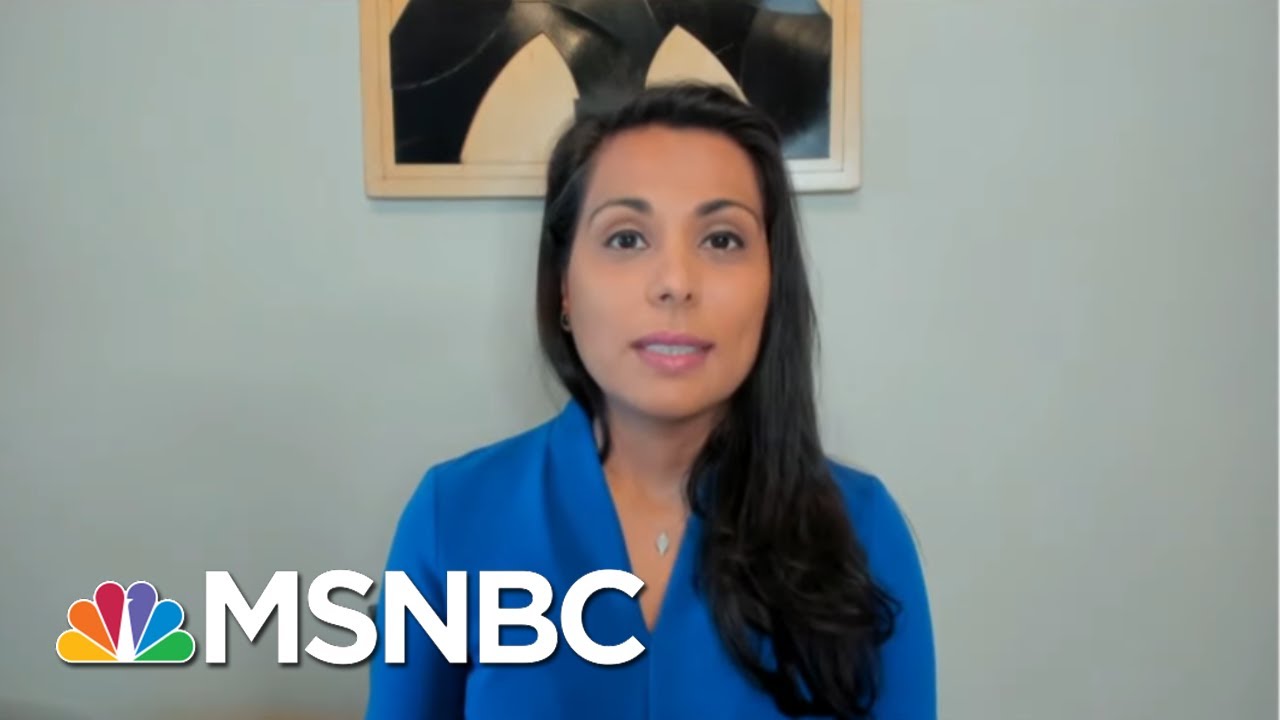Dr. Nahid Bhadelia discusses a possible second wave of coronavirus after states begin to ease restrictions and Memorial Day weekend crowds. Aired on 05/26/2020.
» Subscribe to MSNBC:
MSNBC delivers breaking news, in-depth analysis of politics headlines, as well as commentary and informed perspectives. Find video clips and segments from The Rachel Maddow Show, Morning Joe, Meet the Press Daily, The Beat with Ari Melber, Deadline: White House with Nicolle Wallace, Hardball, All In, Last Word, 11th Hour, and more.
Connect with MSNBC Online
Visit msnbc.com:
Subscribe to MSNBC Newsletter:
Find MSNBC on Facebook:
Follow MSNBC on Twitter:
Follow MSNBC on Instagram:
Public Health Experts Warn Of Second Wave As States Ease Restrictions | MTP Daily | MSNBC






Translation ,” we’re all going to die , stay home !”
Translation is actually – be smart follow the guidelines listen to science and medical experts have self control come together as one help keep you and everyone around you safe. Don’t be selfish!
kande Meyer , it is ultimate foolishness to think others will look out for you
Saynoto Socialists be that as it may at least look out for themselves and the ones they love? And I guess it is foolish of me to think people should be caring and considerate.
Anne Rigby I spent lockdown working, banking, shopping, partying with friends and family, running errands and traveling.
kande Meyer , if you live in America , that would be very foolish
Nice to see the south leading the charge. I’m sure the genius has everything under control. You’ll be fine.
Thragon68 everyone VOTE in november!! End the total insanity
@John O when did going to voter booths become a bad thing….compared to mail-in ballots…it’s the only way
@John O the only way to end the insanity is to drain the globalist swamp from the world
@John O yeah TRUMP 2020!!!!!
@John O THE CORRUPTION CROSSES PARTY LINES https://www.youtube.com/watch?v=4jn7ESfJ0Lc
Trump: The second wave is a dem hoax
@TrumpVirus-19 China is dead to us. The WEST will NEVER again let China have the cushy one sided lop sided lying, cheating, stealing, cheating turn the other cheek BS trade agreement any longer…. If you weren’t so incredibly uninformed, you’d know they are the New Russia…. They are our foe…. Full Stop.
@TrumpVirus-19 Everyone hates us because of fake news and because we aren’t going to get used like before….. You want free everything? Then everyone else has to pay their fair share and ENOUGH of the one sided lopsided trade deals with almost every country we deal with….. I must say your total and utter ignorance is impeccable.
The real viruses are the Fed and the military industrial complex
@Freedom & Liberty Bot You get an *F*
Your statement has tons of content. And no citations. How can I believe anything you said about me if you don’t reference your sources? You give me no choice but to assume you made all of that up about me.
Tell you what, I will extend the deadline before I make your grade final. Good luck and hurry up.
God help our military and responders stay strong
Why is this called a second wave? It never stopped!
@Hamberder King thruth is all around you…if you have the crap out of your ears …and listen https://www.youtube.com/watch?v=qZ_c1s1kUq4
@Freedom & Liberty Bot TRUMP 2020!!!
It never started fool
THE CORRUPTION CROSSES PARTY LINES https://www.youtube.com/watch?v=4jn7ESfJ0Lc
That means the flu never stopped for decades. How many people died?
Experts ???
Whenever you hear anonymous person, leak, source or expert, you know MSDNC is telling a liberal fantasy.
@Freedom & Liberty Bot So true
Not experts,… Still sperts
This virus known no limit
Chinese State Agent?
Wall to wall people people on top of people
arris one pent up demand
arris one jealy?
What the degenerate crowds totally failed to realize this week end was that it was not about their personal risk. No one will care if these degenerates die. Their obscene behavior was risking other people’s lives, was risking our own community health care systems. If our health care systems get overwhelmed, then people also die of heart attacks, broken bones, and appendicitis. The sheer self centered disregard for the structural integrity of America is stunning..
Red Hulk Green Hulk that is what I’m saying yes. We test more and report our findings honestly. I don’t expect you to get it though I do feel a gaslighting incoming… lay it on us
II nosferatu II whatever she has it should hurt
In other words, the democratic deep state corporate beast system antichrist network serpent legion of death just killed alot of people intentionally
@Red Hulk Green Hulk
Brainwashed, demoralized and the rest are lucifers kids and beast system slaves… America is finished, destroyed by the minions of evil. Serpent takeover now brings your untimely death.
The only way out is Christ and u end up in the Creators brimstone Pitts anyway… You lose, sucker.
Dont forget your brimestone bubblebath accessories.
@15k DOW 2022 how can you prove your claim though? I mean your saying the whole world is making up numbers for what? They have stricter lockdowns in most other places. And the number of tests per capita is higher.
you need to get through the first wave for there to be a second wave… no, your first wave is just gonna get bigger.
They have all been wrong
everyone I know is waiting for the next wave before looking for work. We are going to use the stimulus money to help others.
Stay healthy, Chuck Todd
I have a new word for my wife… It is called physical distancing. I already don’t have to listen to her. I am hoping for social appearance next.
CORONAVIRUS
THE SCIENCES
How China’s ‘Bat Woman’ Hunted Down Viruses from SARS to the New Coronavirus
Wuhan-based virologist Shi Zhengli has identified dozens of deadly SARS-like viruses in bat caves, and she warns there are more out there
By Jane Qiu | Scientific American June 2020 Issue
How China’s ‘Bat Woman’ Hunted Down Viruses from SARS to the New Coronavirus
Credit: Richard Borge
ADVERTISEMENT
Editor’s Note (4/24/20): This article was originally published online on March 11. It has been updated for inclusion in the June 2020 issue of Scientific American and to address rumors that SARS-CoV-2 emerged from Shi Zhengli’s lab in China.
The mysterious patient samples arrived at the Wuhan Institute of Virology at 7 P.M. on December 30, 2019. Moments later Shi Zhengli’s cell phone rang. It was her boss, the institute’s director. The Wuhan Center for Disease Control and Prevention had detected a novel coronavirus in two hospital patients with atypical pneumonia, and it wanted Shi’s renowned laboratory to investigate. If the finding was confirmed, the new pathogen could pose a serious public health threat—because it belonged to the same family of viruses as the one that caused severe acute respiratory syndrome (SARS), a disease that plagued 8,100 people and killed nearly 800 of them between 2002 and 2003. “Drop whatever you are doing and deal with it now,” she recalls the director saying.
Shi, a virologist who is often called China’s “bat woman” by her colleagues because of her virus-hunting expeditions in bat caves over the past 16 years, walked out of the conference she was attending in Shanghai and hopped on the next train back to Wuhan. “I wondered if [the municipal health authority] got it wrong,” she says. “I had never expected this kind of thing to happen in Wuhan, in central China.” Her studies had shown that the southern, subtropical provinces of Guangdong, Guangxi and Yunnan have the greatest risk of coronaviruses jumping to humans from animals—particularly bats, a known reservoir. If coronaviruses were the culprit, she remembers thinking, “Could they have come from our lab?”
While Shi’s team at the Wuhan institute, an affiliate of the Chinese Academy of Sciences, raced to uncover the identity of the contagion—over the following week they connected the illness to the novel coronavirus that become known as SARS-CoV-2—the disease spread like wildfire. By April 20 more than 84,000 people in China had been infected. About 80 percent of them lived in the province of Hubei, of which Wuhan is the capital, and more than 4,600 had died. Outside of China, about 2.4 million people across 210 or so countries and territories had caught the virus, and more than 169,000 had perished from the disease it caused, COVID-19.
The New Coronavirus Outbreak: What We Know So Far
Read more from this special report:
The New Coronavirus Outbreak: What We Know So Far
Scientists have long warned that the rate of emergence of new infectious diseases is accelerating—especially in developing countries where high densities of people and animals increasingly mingle and move about. “It’s incredibly important to pinpoint the source of infection and the chain of cross-species transmission,” says disease ecologist Peter Daszak, president of EcoHealth Alliance, a New York City–based nonprofit research organization that collaborates with researchers, such as Shi, in 30 countries in Asia, Africa and the Middle East to discover new viruses in wildlife. An equally important task, he adds, is to hunt down other pathogens to “prevent similar incidents from happening again.”
OUTSIDE A BAT CAVE in China’s Guangxi province in 2004, Shi Zhengli releases a fruit bat after taking a blood sample. Credit: Shuyi Zhang
THE CAVES
To Shi, her first virus-discovery expedition felt like a vacation. On a breezy, sunny spring day in 2004, she joined an international team of researchers to collect samples from bat colonies in caves near Nanning, the capital of Guangxi. Her inaugural cave was typical of the region: large, rich in limestone columns and—as a popular tourist destination—easily accessible. “It was spellbinding,” Shi recalls. Milky-white stalactites hung from the ceiling like icicles, glistening with moisture.
But the holidaylike atmosphere soon dissipated. Many bats—including several insect-eating species of horseshoe bats that are abundant in southern Asia—roost in deep, narrow caves on steep terrain. Often guided by tips from local villagers, Shi and her colleagues had to hike for hours to potential sites and inch through tight rock crevasses on their stomachs. And the flying mammals can be elusive. In one frustrating week, the team explored more than 30 caves and saw only a dozen bats.
These expeditions were part of the effort to catch the culprit in the SARS outbreak, the first major epidemic of the 21st century. A Hong Kong team had reported that wildlife traders in Guangdong first caught the SARS coronavirus from civets, mongooselike mammals that are native to tropical and subtropical Asia and Africa.
Before SARS, the world had only an inkling of coronaviruses—so named because their spiky surface resembles a crown when seen under a microscope, says Linfa Wang, who directs the emerging infectious diseases program at Singapore’s Duke-NUS Medical School. Coronaviruses were mostly known for causing common colds. “The SARS outbreak was a game changer,” Wang says. It was the first emergence of a deadly coronavirus with pandemic potential. The incident helped to jump-start a global search for animal viruses that could find their way into humans. Shi was an early recruit of that effort, and both Daszak and Wang have been her long-term collaborators.
With the SARS virus, just how the civets got it remained a mystery. Two previous incidents were telling: Australia’s 1994 Hendra virus infections, in which the contagion jumped from horses to humans, and Malaysia’s 1998 Nipah virus outbreak, in which it moved from pigs to p
The second wave will hit right before the election in November…
#VoteDemocrat
#VoteByMail
#VoteOften
Truth Ninja Ima wave riding ninja. Bring it on, I need some pipelines to carve up. #YOUAIN’TBLACK MY NINJA
MSLSD you got caught big TIME
Test
Sad to think it all could have been avoided we feel for you
TRUMPS “Joe McCarthy moment ” “at long last, have you no sense of decency “
It’s never too late to jump on the BS train.